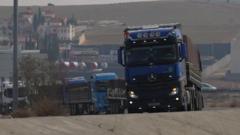On a sunlit winter morning, a monumental aid convoy has departed Jordan, driving towards the Gaza Strip, loaded with essential supplies for its residents. Mustafa al Qadri, one of the drivers, peers through his windscreen at the long procession of trucks making their way towards the Jordan Valley, where they will navigate Israel customs at the King Hussein/Allenby Bridge border crossing before proceeding to Gaza via the Erez crossing.
Inside their vehicles, drivers are aware of the grave risks they face: blocked roads by Israeli settlers and dangerous hijackings in the region’s war-torn landscape. Yet, the sentiment within the convoy is characterized by resilience and camaraderie. As al Qadri states, “We are carrying aid like food and medication for our brothers in Gaza,” emphasizing the deep connections many Jordanians feel towards Palestinians. His refrain of “brothers” encapsulates a profound sense of shared humanity intertwined with historical ties.
As the convoy makes its way, enthusiasm fills the air with horn blasts and waves to onlookers—a testament to Gaza being a crucial cause in Jordan. Jordan's King Abdullah II has been instrumental in rallying support for this massive operation, the biggest since the conflict escalated in October 2023, comprising 120 trucks. Together with the international community's assurances for future aid, the mission affirms that Gazans are not alone in their plight.
The United Nations emphasizes the urgency of providing aid, with Secretary General Antonio Guterres alerting against the backdrop of catastrophic humanitarian levels. A staggering 90% of Gaza's 2.2 million inhabitants are now displaced, relying on aid to survive. Despite facing accusations of delaying aid distribution, Israeli authorities maintain they do not obstruct these efforts, even contending that U.S. military support was at risk over the limited humanitarian assistance being allowed to Gaza.
In central Gaza, distressing scenes reveal the realities facing families, with children like Lamees Mohammad Al Mizar’i, a sixteen-year-old from Gaza City, queuing desperately for food. Reflecting on her past, she laments the transformation of her relationship with meals—her once-picky eating habits abandoned in the face of stark hunger. “I have to come here. I keep thinking that if I don't come we won't find anything to eat,” Lamees shares, illustrating the everyday struggles and pressing familial tensions underlined by scarcity.
As efforts continue to prepare aid for Gaza's delivery, the Jordanian Hashemite Charity Organisation is poised to send 150 trucks each day given the green light. With organizations, the UN, and various groups eager to contribute, the overarching hope remains—the full opening of Gaza’s borders for essential aid and the eventual restoration of peace within the region.





















